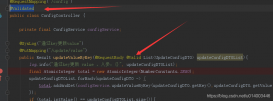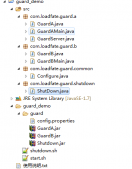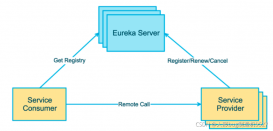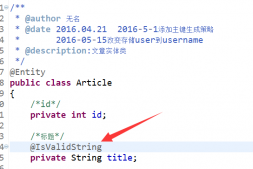在没有使用spring boot之前,我们的做法是在配置文件中定义一个任务池,然后将@Async注解的任务丢到任务池中去执行,那么在spring boot中,怎么来实现异步任务的调用了,方法更简单。
我们还是结合前面
spring boot整合JMS(ActiveMQ实现)
这篇博客里面的代码来实现。
一、功能说明
消费者在监听到队列里面的消息时,将接收消息的任务作为异步任务处理。
二、代码修改
消费者1:
|
1
2
3
4
5
6
7
8
9
10
11
12
|
package com.chhliu.springboot.jms; import org.springframework.jms.annotation.JmsListener; import org.springframework.scheduling.annotation.Async; import org.springframework.stereotype.Component; @Componentpublic class Consumer { @JmsListener(destination = "mytest.queue") @Async //该方法会异步执行,也就是说主线程会直接跳过该方法,而是使用线程池中的线程来执行该方法 public void receiveQueue(String text) { System.out.println(Thread.currentThread().getName()+":Consumer收到的报文为:"+text); } } |
消费者2:
|
1
2
3
4
5
6
7
8
9
10
11
12
13
|
package com.chhliu.springboot.jms; import org.springframework.jms.annotation.JmsListener; import org.springframework.messaging.handler.annotation.SendTo; import org.springframework.stereotype.Component; @Componentpublic class Consumer2 { @JmsListener(destination = "mytest.queue") @SendTo("out.queue") public String receiveQueue(String text) { System.out.println(Thread.currentThread().getName()+":Consumer2收到的报文为:"+text); return "return message"+text; } } |
在测试类上添加如下注解:
|
1
2
3
4
5
6
7
8
9
10
11
12
13
14
15
16
17
18
19
20
21
22
23
|
package com.chhliu.springboot.jms; import javax.jms.Destination; import org.apache.activemq.command.ActiveMQQueue; import org.junit.Test; import org.junit.runner.RunWith; import org.springframework.beans.factory.annotation.Autowired; import org.springframework.boot.test.context.SpringBootTest; import org.springframework.scheduling.annotation.EnableAsync; import org.springframework.test.context.junit4.SpringRunner; @RunWith(SpringRunner.class) @SpringBootTest@EnableAsync // 开启异步任务支持 public class SpringbootJmsApplicationTests { @Autowired private Producer producer; @Test public void contextLoads() throws InterruptedException { Destination destination = new ActiveMQQueue("mytest.queue"); for(int i=0; i<100; i++){ producer.sendMessage(destination, "myname is chhliu!!!"); } } } |
三、测试结果
|
1
2
3
4
5
6
7
8
9
10
11
12
13
14
15
16
17
18
19
|
DefaultMessageListenerContainer-1:Consumer2收到的报文为:myname is chhliu!!! 从out.queue队列收到的回复报文为:return messagemyname is chhliu!!! SimpleAsyncTaskExecutor-45:Consumer收到的报文为:myname is chhliu!!! DefaultMessageListenerContainer-1:Consumer2收到的报文为:myname is chhliu!!! 从out.queue队列收到的回复报文为:return messagemyname is chhliu!!! SimpleAsyncTaskExecutor-46:Consumer收到的报文为:myname is chhliu!!! DefaultMessageListenerContainer-1:Consumer2收到的报文为:myname is chhliu!!! 从out.queue队列收到的回复报文为:return messagemyname is chhliu!!! SimpleAsyncTaskExecutor-47:Consumer收到的报文为:myname is chhliu!!! DefaultMessageListenerContainer-1:Consumer2收到的报文为:myname is chhliu!!! 从out.queue队列收到的回复报文为:return messagemyname is chhliu!!! SimpleAsyncTaskExecutor-48:Consumer收到的报文为:myname is chhliu!!! DefaultMessageListenerContainer-1:Consumer2收到的报文为:myname is chhliu!!! 从out.queue队列收到的回复报文为:return messagemyname is chhliu!!! SimpleAsyncTaskExecutor-49:Consumer收到的报文为:myname is chhliu!!! DefaultMessageListenerContainer-1:Consumer2收到的报文为:myname is chhliu!!! 从out.queue队列收到的回复报文为:return messagemyname is chhliu!!! SimpleAsyncTaskExecutor-50:Consumer收到的报文为:myname is chhliu!!! DefaultMessageListenerContainer-1:Consumer2收到的报文为:myname is chhliu!!! |
从上面的测试结果可以看出,由于消费者2没有使用异步任务方式,所以消费者2消费消息都是由固定的线程DefaultMessageListenerContainer-1这个线程来处理的,而消费者1由于使用了异步任务的方式,每次处理接收到的消息都是由不同的线程来处理的,当接收到消息时,直接将任务丢到任务池中去处理,而主线程则继续跑,从测试结果中还可以推断出,spring boot默认使用了newCachedThreadPool线程池来实现。
关于线程池的具体用法,请参考我的另一篇博文:https://www.zzvips.com/article/153012.html
四、异步任务有返回
在实际的开发中,我们会经常遇到异步任务有返回的情况,那么在spring boot中,怎么来实现了?
下面以异步发邮件为例,来进行说明,示例代码如下:
|
1
2
3
4
5
6
7
8
9
10
11
12
|
@Async("taskExecutePool") // 异步任务会提交到taskExecutePool任务池中执行 public Future<Response> doSendEmail(MailInfo mailInfo) {// 异步任务返回,使用Future<Response>来异步返回 log.info(Thread.currentThread().getName()+"调用了doSendEmail异步方法!"); SendMailSession session = null; Response res = new Response(); boolean isOK = sendEmail(mailInfo);// 具体发邮件的方法 if(isOK){ res.setSuccess(true); }else{ res.setSuccess(false); } return new AsyncResult<Response>(res); |
返回之后怎么使用?示例代码如下:
|
1
2
|
Future<Response> result = taskJob.doSendEmail(mailInfo); res = result.get(6, TimeUnit.SECONDS); |
这样就可以获取到异步任务的返回了!
总结
以上所述是小编给大家介绍的spring boot异步(Async)任务调度实现方法,希望对大家有所帮助,如果大家有任何疑问请给我留言,小编会及时回复大家的。在此也非常感谢大家对服务器之家网站的支持!
原文链接:http://blog.csdn.net/liuchuanhong1/article/details/54605697

















